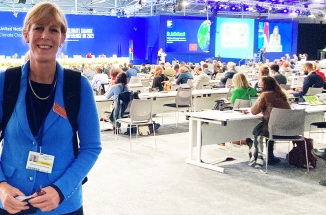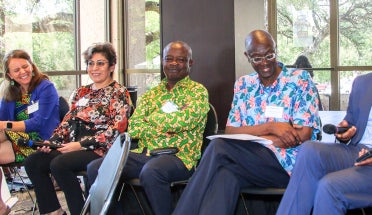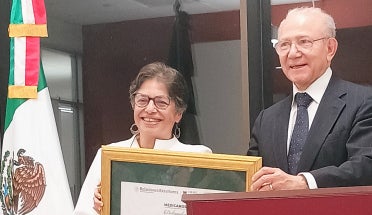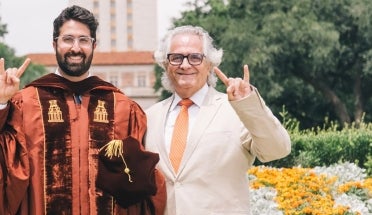
Jackson School Researcher Advocates for Carbon Capture and Storage at COP26 in Glasgow
- Feb 1, 2022
- by Alex Briseño and Sophia Aitken
With more than 20 years of research under its belt, The University of Texas at Austin is leading the charge in carbon capture and storage (CCS), a method of mitigating carbon dioxide (CO2) pollution. The next step is continuing the push for global implementation to reduce emissions and fight climate change.
Katherine Romanak, Ph.D., a research scientist at UT Austin’s Jackson School of Geosciences, felt that responsibility weigh heavily when she attended the most recent Conference of the Parties (COP). This global climate summit annually brings together representatives of countries from across the world to set goals for reducing the effects of climate change.
In November, at COP26 in Glasgow, Scotland, Romanak explained the safety and viability of CCS as a climate game-changer and invited countries to explore the potential of implementing it.
The CCS process is made up of three components: carbon capture and carbon storage, with transport connecting the two. At the Gulf Coast Carbon Center, part of UT Austin’s Bureau of Economic Geology, innovation in the carbon storage side of the equation has been moving forward for two decades.
Romanak has monitored the environmental impact of carbon storage and advocated for CCS at the highest level since participating in COP17 in 2011, returning most recently at COP26 to share her updated data.
“We are one of the most experienced groups in the world on CCS,” said Romanak. “I see it almost as an obligation, that we have to help countries become aware of this as a possibility.”
With that commitment in mind, Romanak and UT Austin are producing results. The university’s carbon storage scientists have successfully collaborated with colleagues in Trinidad and Tobago to implement CCS and are now working with Nigeria and China.

‘It’s finally catching on’
CCS has the capacity to reduce millions of tons of carbon dioxide that otherwise would be released into the atmosphere.
In the process, CO2 is captured at an industrial point source (such as power plants, steel refineries or cement plants) and pressurized into a liquid-like fluid, then transported and pumped into a porous geologic formation 1-2 kilometers below ground. There, it’s unable to escape due to an overlying nonporous sediment cap—essentially mimicking the way fossil fuels are naturally stored in the earth. Additional processes work over time to eventually mineralize the CO2.
Romanak’s push to widely implement CCS has not gone without major obstacles, one of the largest being public perception, which she says presents an “uphill battle.”
“There are a lot of people who don't understand carbon capture and storage. They think, wrongly, that it’s an evil plan by evil oil companies to keep doing what they do. They just have the wrong picture, and so they automatically come out saying it's a ‘unicorn technology,’ it ‘doesn't exist’ or it's ‘not safe,’” said Romanak.
“But the Intergovernmental Panel on Climate Change, which is the internationally accepted authority on climate change science, has accepted CCS as a critically important technology,” she continued. “If the public can understand that geologic mechanisms hold onto that CO2 and make it so that you couldn't get it out even if you wanted to, they may feel better about it.”
Despite the fight against public misperception, Romanak noted that there has been a rise in interest in this emissions reduction strategy. This interest arrives as the need to act on climate change becomes more urgent than ever. As Romanak explained, CCS is a key mitigation technology that needs to be scaled up quickly in order to meet climate goals, especially the efforts to phase down unabated fossil fuels.
“The International Energy Agency says we need to upscale CCS by two orders of magnitude—by 100 times from where it is now—in order to meet our climate goals,” said Romanak.
However, she adds, “It’s not happening right now. Right now, we’re storing 40 megatons per year of CO2, and by 2035, we need to be storing 4,000 megatons. The bottom line is: It’s really important to input technical information into [the COP].”
Another challenge, Romanak notes, is that 75 percent of these emission reductions need to come from developing countries. In recent COPs, Romanak invited representatives from developing countries to learn more about how they can move forward on CCS, since they need to play such a key role in emission reductions.
With her work in Trinidad and Tobago considered a success story, Romanak also highlighted the momentum CCS is gaining around the world. Canada and Norway have joined the United States as leaders, Romanak says. But more countries are making a push, as Australia and the United Kingdom jump on board, while South Africa, Indonesia and Nigeria are coming along, as well.
“It's good; this is what we need,” said Romanak. “It's finally catching on, and developing countries are now really interested.”
Leading the way
In December 2021, the university’s Department of Chemical Engineering researchers entered into a licensing agreement with Honeywell to commercialize another carbon capture technology created at UT Austin, which will be used to reduce carbon emissions from industrial points around the globe.
“The licensing agreement with Honeywell enables us to commercially scale this in ways that can make major contributions toward zero-emission efforts to address global warming and to reduce pollutants in surrounding communities,” said Gary Rochelle, professor in the McKetta Department of Chemical Engineering and leader of Texas Carbon Management Program at UT Austin.
After years of work, Rochelle’s team created a second-generation amine scrubbing system, opening the door to address “hard to abate” industries like steel, cement and chemical plants, along with coal, natural gas and bio-energy power plants.
This technology specifically reduces the costs of capturing carbon dioxide emissions before it enters the atmosphere. It allows CO2 to be absorbed into an amine solvent. It is then separated from the solvent and compressed for geological sequestration or utilized for other purposes.
Applying this technology to just one single typical power plant would allow for the capture of roughly 3.4 million tons of carbon dioxide each year. That’s the equivalent of removing nearly 735,000 cars from the road each year—and Honeywell intends to apply this technology globally.
‘I did it—and any woman can do it’
As for Romanak, the career path that led her to this groundbreaking work on the global scale wasn’t linear in trajectory.
“I got my Ph.D. two weeks before the birth of my second son,” said Romanak. “I was a mom for 13 years, and then I decided to try to get back into this.”
Just a year and a half after making her return to academic research into CCS, Romanak was in the United Nations, discussing the importance of CCS. From there, she hasn’t looked back.
“There’s another message here for women—and women who want to have professions: You can do it,” said Romanak. “I had such a long way to get back into this world, but I did it. And any woman can do it. You can have it.”
From addressing resistant public perception on the global stage to working in collaboration with developing countries, Romanak says her passion now is to communicate and get as many questions answered as she can, using the experience she has behind her: 15 years of research and implementation, to be exact.
“It's quite an honor to be able to go to these COPs,” said Romanak. “That's where the fate of the planet is being decided.”



